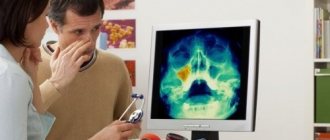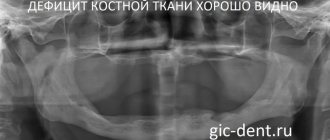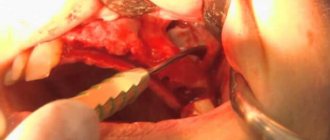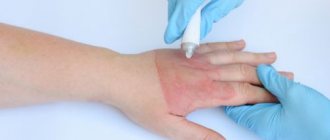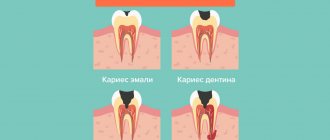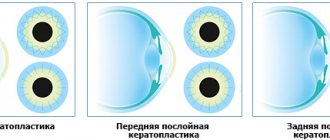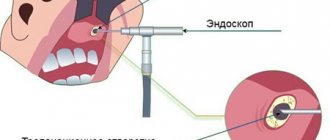The symptoms of mucosal hypertrophy do not differ significantly from a simple runny nose.
Changes in the condition of the mucous membrane lining the inner surface of the supramillary sinus are caused by various processes and conditions of the ENT organs. Thickening of the mucous membrane of the maxillary sinuses is a precursor to the development of a serious inflammatory process.
Causes of thickening of the membranes
The internal tissues of the maxillary sinuses increase in volume in the following cases:
- improper treatment of rhinitis;
- frequent respiratory diseases;
- long-term allergic reactions;
- hypothermia of the body;
- if a polyp has formed in the sinus area;
- severe infectious diseases;
- acute states of deficiency of any vitamin;
- with congenital structural features of the nasal passages;
- when a foreign body enters the nasal cavity;
- when a patient takes hormonal drugs for various purposes.
Important: the prognosis of the course of the disease directly depends on the degree and area of tissue thickening; the more insignificant it is, the more likely a rapid and complete recovery is.
Changes in the mucosa can occur not only in the maxillary sinuses, but also in the frontal and ethmoid sinuses. In this case, the mucous membrane degenerates into connective tissue.
Thickening of the mucous membrane of the maxillary sinus is one of the components of the following diseases:
- chronic sinusitis (purulent, purulent-polypous, necrotic, parietal hyperplastic forms);
- allergic reactions and rhinitis.
If the acute form of the disease is not treated, it transforms into a chronic course of the disease. In this case, the condition periodically worsens, the symptoms intensify, which each time become more and more difficult to relieve. An inflammatory process that lasts more than two months is considered to be a chronic form of the condition.
Removal of sinus cyst without surgery
If a sinus cyst is detected, treatment without surgery is carried out using decongestant sprays, antibiotics, painkillers, mucolytics, steroids and antihistamines. They treat concomitant diseases - allergies, sinusitis, inflammatory processes of the gums, teeth, nasal mucosa. In combination with these drugs, various means for rinsing the nasal cavity, regenerating and restorative sprays are used. Treatment is prescribed by the doctor based on the results of the patient’s examination.
Symptoms of tissue thickening
Signs of changes in the condition of the maxillary sinus mucosa are not specific only to this case.
Important: the constant inflammatory process changes the mucous membrane, cracks form in it, and polyps grow.
The symptoms are similar to most symptoms of respiratory diseases.
The chronic condition is characterized by the following complaints from patients:
- Breathing is difficult both when inhaling and exhaling.
- Constant nasal discharge, which has a different appearance and consistency.
- Often the discharge smells like pus. It can be felt even when the patient breathes.
- It is difficult for the patient to blow his nose; there is a feeling of mucus, but it is difficult to remove it from the nasal cavity.
- This condition is characterized by a deterioration in the sense of smell, up to its complete loss.
- The patient's voice becomes nasal, the person speaks “into his nose.”
- There may be complaints of congestion, pain and tinnitus.
- If an increase in mucous occurs due to the development of sinusitis, then in the initial stages the mucus will be liquid. At this stage, sinusitis is catarrhal. As the disease progresses, it will become thicker and thicker. The development of a purulent stage of the disease is possible.
- Sometimes, when the mucous membrane of the maxillary sinuses thickens, a person’s eyelids swell and their eyes water. Their soreness may mistakenly suggest conjunctivitis.
- Headaches come in varying intensity, nature and location.
- Allergic reactions are accompanied by a liquid state of mucus discharged from the nose.
- In the cheek area, on the sides of the nose, pain appears, increasing with pressure.
- During an exacerbation, the body temperature rises and the condition worsens sharply.
When the acute stage passes, even if the condition has already become chronic, the patient begins to feel better. The satisfactory condition lasts until the next onset of the acute stage.
The patient gets used to his condition and the alternation of these periods; he does not consult a doctor.
Mechanisms of changes in the structure of the mucosa
Thickening of the internal tissues of the maxillary sinuses occurs according to the following principle:
- When the disease occurs, swelling and thickening occur. The ducts that remove mucus from the sinuses are located on the surface of the mucous membranes, which means that when there is swelling, they are blocked. The mucous membrane performs its function of producing mucus. In case of illness, it is produced more than in a normal situation.
- Excess mucus remains in the sinus, causing pressure. The walls of the sinus begin to stretch.
- With increased pressure, cysts grow. These formations are subject to uncontrolled growth in size.
- If pathogenic organisms penetrate the sinus cavity, the cyst tissue becomes inflamed.
- The cells begin to produce pus, which has no way out of the cavity.
Treatment of symptoms of maxillary sinusitis
Symptomatic treatment of sinusitis includes topical decongestants (such as xylometazoline and oxymetazoline) that improve sinus ventilation, mucolytics (such as carbocysteine) that improve mucus secretion, topical antiseptics (miramistin and others) and irrigation therapy (such as nasal douches). , before using which you need to use vasoconstrictor drugs), which flush out mucus and kill microbes in the sinus cavity, topical glucocorticosteroids, combined drugs (non-steroidal and anti-inflammatory drugs - paracetamol, ibuprofen).
Among the most effective drugs for treating the symptoms of sinusitis are
Sialor based on silver ions . It has an anti-inflammatory effect and prevents the proliferation of bacteria. Thanks to the mild action of the drug, the balance of microflora is maintained and favorable conditions are created for the regeneration of the nasal mucosa.
Surgical intervention
Drug treatments are not always effective; sometimes it is necessary to resort to surgery. At the same time, both approaches to diseased sinuses (extranasal, endonasal, combined), surgical technologies (magnifying devices and lighting devices), and surgical methods differ.
Important: after sinusitis, patients should be periodically (at least once every 3 months) observed by an otolaryngologist.
Treatment at home
An option for treating maxillary sinusitis at home is steam inhalation, which improves blood circulation, thins mucus accumulations, and also improves the flow of medications from the blood. But in acute cases of maxillary sinusitis, this method is dangerous; it can provoke generalization of the infectious process.
You can do inhalations with a decoction of herbs (calendula, celandine, bay leaf, string of sage, chamomile). Add alcohol tincture of propolis (1 teaspoon per 0.5 liter of decoction) and a couple of drops of iodine to boiling water.
In addition to such inhalations, you can also breathe over boiled potatoes. Important: you need to breathe for 10 minutes every day, the course is a week.
Warm the nose with table salt in a bag, boiled with an egg, and a blue lamp. Rinse the nose with the following solution: 1 teaspoon per glass, furatsilin (2 tablets), herbal decoctions (sage, celandine, chamomile). The procedure can be repeated up to 10 times a day.
What does long-term lack of treatment lead to?
Important: degeneration of mucous tissue is very dangerous, as malignant formations may occur.
Long-term changes in the shape and volume of the mucous membrane of the maxillary sinuses lead to hypertrophy of the maxillary sinuses. The nasal septums shift, and the patient begins to experience serious breathing problems.
In addition, the displacement of the shells disrupts their symmetrical arrangement. Impaired free nasal breathing will negatively affect the condition of the entire body. On performance, sleep status, mental balance, oral health and much more.
Changes in the condition of the nasal turbinates affect the condition of their mucous tissue.
The following happens:
- the asymmetry of the shells provokes uneven air inhalation, the mucous membrane of the shells becomes inflamed;
- when trying to cope with increased loads, the membrane grows, hypertrophy of the mucous membrane of the nasal concha begins;
- secretion increases.
Important: hypertrophic changes in the nasal mucosa can also be provoked by physical impact, trauma to the nose and face.
The purulent stage of the development of the situation is especially dangerous.
Purulent processes in the sinus will have the following symptoms:
- congestion occurs periodically, can be unilateral or bilateral;
- nasal discharge – cloudy, white;
- the jaw, forehead, and sides of the nose hurt;
- the general condition of the patient is rapidly deteriorating;
- the temperature rises.
Interpretation of the radiograph
The presence of exudate in the nasal sinuses indicates the presence of an acute inflammatory process, and thickening of the walls of the nasal sinuses and narrowing of their lumen may indicate chronic inflammation.
Subtotal darkening of the maxillary sinuses
A horizontal fluid level may indicate inflammatory diseases of the maxillary sinuses (sinusitis).
Subtotal darkening with an upper horizontal level in the area of the maxillary sinuses may indicate sinusitis.
If the darkening is localized in the frontal sinuses, then this indicates the development of frontal sinusitis.
To diagnose tumors, radiography with a contrast agent is performed. This helps to better see the location of the tumor and its size. When contrast is introduced, tumor formations “absorb” the pigment and become more visible.
Establishing diagnosis
With the help of rhinoscopy, a preliminary conclusion can be made
The following methods are used to diagnose the disease:
- X-ray examination;
- MRI;
- Rhinoscopy.
The research method is prescribed by the attending physician. Often you have to resort to more than one method. It is especially important during the examination to determine the exact location of mucosal hypertrophy.
Important: it is not possible to cure this disease at home, since a diagnosis can only be made after a series of procedures and consultation with a specialist.
In case of a serious condition of the patient, surgical intervention will be indicated. The video in this article and photos will explain the features of x-ray diagnostics.
X-ray is the main diagnostic method when there is a suspicion of thickening of the mucous membrane of the maxillary sinuses
What is maxillary sinusitis?
A person has several types of sinuses: frontal, sphenoid, maxillary and cells of the ethmoid labyrinth.
In each of these types, inflammation of the mucous membrane can occur. Then sinusitis will begin. Maxillary sinusitis is otherwise called sinusitis and is an inflammation of the paranasal sinuses. The maxillary sinuses were first illustrated by Leonardo da Vinci, and the disease itself was discovered by Nathaniel Highmore, a British surgeon and anatomist (he also described the maxillary sinuses in detail in his treatise of 1651). At that time, sinusitis was treated with home methods and heating.
Surgical methods for treating hypertrophy
Hyperplasia of the mucous membrane of the maxillary sinuses can be cured by certain surgical methods.
Surgical treatment methods:
| Method name | Main tool | How to do it |
| Galvanocaustics | Electrode | It is performed under local anesthesia. The pathological area is cauterized. After the procedure there is a recovery period, the formed scar resolves. Nasal breathing is completely restored. |
| Conchotomy | Wire loop | The technique involves resection of the enlarged mucosa. |
Upon completion of the procedure, the doctor should give detailed instructions about the features of the postoperative period.
In addition to surgical methods, drug support is prescribed:
- antihistamines;
- drugs to strengthen blood vessels;
- rinsing the sinuses and nasal turbinates with medicinal solutions;
- performing inhalations.
For successful treatment, the main thing is to see a doctor on time
Thickening and swelling of the mucous membrane of the maxillary sinuses causes pathological formation of mucus and pus. Pathogenic microorganisms successfully live in such an environment. This proximity is especially dangerous for the membranes of the human brain, which are located near the maxillary sinuses.
This disease cannot be determined independently, which means that even with a simple runny nose you need to consult a specialist. Self-medication in this case gives false hope, wastes precious time, the cost of which is very high, and is harmful to health.
Conservative treatment
Thickening of the mucous membrane of the maxillary sinuses in catarrhal and purulent forms is treated using conservative methods. Medicines, physiotherapy and other methods to alleviate the condition are used.
Drainage of secretions
In case of acute development of pathology, it is necessary to use a special small bulb, which can be purchased at a pharmacy. It helps remove liquid mucus and make breathing easier. The procedure must be carried out with caution 2 to 4 times a day.
Additionally, it is recommended to use vasoconstrictor drops, for example, Naphthyzin, Rhinorus or Xylometazoline. They have a pronounced effect and make breathing easier within 4-5 minutes. Drops can be administered no more than 3 times a day, the maximum course duration is 10 days.
Antibiotics
For purulent inflammation, antibacterial drugs are a mandatory element of therapy. Experts prescribe medications from different groups, which are selected individually for each patient.
The most effective medications:
- Augmentin – an effective remedy from the penicillin group, helps to quickly destroy bacteria and prevent complications. It is prescribed for any form of pathology when body temperature rises and concomitant disorders appear. The patient receives 2 intravenous injections per day. For 1 time, take 1 bottle of the drug and add 10 ml of sodium chloride. Treatment lasts at least 10 days. The drug is not used during pregnancy, intolerance to its components and severe liver damage.
- Ceftriaxone is used quite often for hypertrophy with signs of suppuration. It is highly effective and helps to quickly eliminate common symptoms. The patient receives 2 to 4 g of medication intravenously or intramuscularly per day, depending on the severity of the condition. Treatment lasts from 7 to 14 days. The drug is contraindicated in patients with severe liver and kidney damage, as well as those with allergies to its components.
- Azitral is one of the most effective antibiotics that helps destroy pathogenic microorganisms in a short period. Prescribed for severe hypertrophy with signs of suppuration and the formation of polyps. Not used if the components are intolerant. The daily dosage for a patient ranges from 1-2 g, depending on the severity of symptoms. The course lasts no more than 10 days, most often 1 week is enough. Tablets are taken orally 2-4 per day.
- Clarithromycin is an effective medication that is used for severe purulent hypertrophy. The medicine is taken 1 tablet 2-3 times a day, depending on the severity of the disease. The course lasts up to 10 days. The drug is contraindicated in patients with allergies to its composition, as well as end-stage renal failure.
There are other medications; the selection of the drug is carried out taking into account the individual characteristics of each patient and the degree of neglect of the condition.
Natural drops
Thickening of the mucous membrane of the maxillary sinuses of the catarrhal type responds well to treatment with drops based on natural ingredients.
- The most popular medicine is Pinosol. This medicine contains eucalyptus essential oil, due to which the therapeutic effect is achieved. Prescribed for any pathologies of the nasal sinuses, accompanied by congestion and secretion of mucus in large quantities. It is necessary to instill drops 2-3 times per day, repeat for 1-2 weeks. The only contraindication is an allergy to the composition of the medicine.
- Sinuforte is a product of plant origin, which is available in the form of a lyophilisate for preparing a solution. After receiving the drops, they must be injected into the nasal passages 3 times a day. Treatment lasts up to 2 weeks. The medication helps relieve swelling, is used for catarrhal hypertrophy, dilutes mucus and removes it from the sinuses. You should not use the medication in case of polypous form of pathology, under the age of 12 years, as well as uncontrolled arterial hypertension.
- Aqua Maris - natural drops based on sea water. They are used only in the initial stages of catarrhal hypertrophy in the absence of complications. They help remove mucus from the sinuses, while slightly drying out the mucous membranes, but do not provoke vasoconstriction. The drug is absolutely safe for adults and children; it is not used if the main component of the composition is intolerant. It is worth using drops 3-4 times a day, injecting them into the nasal passages. Course duration is up to 2 weeks.
Physiotherapy
Therapy using physiotherapy is used only in the absence of acute symptoms of inflammation, complications, and the patient’s body temperature is normal. In the case of a purulent type of pathology, such treatment is strictly contraindicated; it is not used when polyps appear in combination with purulent inflammation.
Warming up is the most popular method. The procedure is carried out on an outpatient basis and lasts up to 20 minutes. During the manipulation, special cannulas are inserted into the patient's nasal sinuses, through which heat enters the sinuses. The course consists of 10-15 sessions, helps to significantly improve the patient’s condition, warming stimulates the restoration of the mucous membrane.
UHF therapy is considered a good way to accelerate the recovery of mucous membranes. At the same time, ultra-high frequency waves act on the tissue, which leads to rapid regeneration. The procedure lasts 15-20 minutes and is carried out 3-4 times a week. The course consists of 12-15 sessions.
It is important to remember that in the acute stage any procedures are contraindicated. But in the absence of acute symptoms, they help enhance the effectiveness of medications.
Folk remedies
Subtotal darkening of the maxillary sinuses can be treated using traditional methods. Medicines based on medicinal plants are also used in the treatment of inflammatory diseases of the upper respiratory tract. For this purpose, saline solutions, drops, and compresses are used.
The only contraindication is an allergic reaction to the components of the drug.
For young children under 1 year of age, traditional treatment methods should be used with caution so as not to provoke the development of an allergic reaction.
Mustard oil
Rhinitis and sinusitis can be treated with mustard oil. To do this, the oil must be slightly heated, but the temperature must be comfortable so that when the oil is instilled into the nose, the mucous membrane does not burn.
Place 3-4 drops of oil into each nasal passage 2 times a day. The oil has anti-inflammatory and antiviral effects, and also reduces swelling of the nasal mucosa.
Garlic
Garlic has antibacterial properties and can be used to make drops for the common cold. To do this, you need to take 2 cloves of garlic, pass through a press, place in gauze (folded in several layers) and squeeze out the resulting juice.
Then add 3-4 tbsp to the garlic juice. l. water or 2 tbsp. l. olive oil. This must be done so that garlic juice does not lead to a burn of the mucous membrane.
For the first use, 1 drop is instilled into each nasal passage. If no allergic reaction subsequently occurs, then you can instill 2-3 drops into each nasal passage for 7 days.
Such drops are prohibited for use by children. Since the mucous membrane in children has a more immature structure compared to adults. Instillation of such drops may cause burns.
In addition to drops, garlic can be used as an air disinfectant. To do this, the garlic is first peeled and cut into small pieces. Garlic is laid out on plates and placed at different ends of the room. Since garlic is a natural antiseptic, its action will deactivate viruses and bacteria that are released by a sick person.
Propolis solution
To treat sinusitis, use a propolis solution. To do this, take a 10% alcohol solution of propolis. Before use, dilute a small amount with water so as not to irritate the mucous membrane. You need to instill 1-2 drops into each nasal passage for 7 days.
Due to the alcohol content, this method of treatment is contraindicated for children.
Aloe juice
Aloe is used not only to treat inflammatory diseases, but also to prevent viral infections.
For this purpose, drops can be prepared from aloe juice. To do this, take aloe juice and mix it with water in a 3:1 ratio. If such drops are indicated for a small child, then the proportion is 5:1. You need to instill 2-3 drops into each nasal passage for 10 days.
Black radish
Any compresses are prohibited in the phase of acute inflammation, as well as at elevated body temperature. A black radish compress is effective in reducing swelling of the mucous membrane.
To prepare such a compress, you need to take one radish, peel it and grate it. Then you need to mix with vegetable oil and heat slightly. Apply the prepared pulp to the sinus area for 10 minutes. You can use thin cloth or gauze for this purpose. The course of treatment with this remedy is no more than 7 days.
Sea salt
A hypertonic sea salt solution can be purchased at a pharmacy, or you can prepare it yourself at home.
For this purpose, you need to take ½ teaspoon of sea salt and dissolve its contents in a glass of warm water. Then you need to draw the required amount of solution into a sterile syringe and rinse each nasal passage one by one. It is recommended to rinse your nose with saline solution up to 5 times a day.
Children need to rinse their nasal passages by instillation. Until the age of 3, the nasal passages should not be washed with sprays or a syringe. Since a strong stream of solution can promote the advancement of microorganisms to the auditory tube. Since the auditory tube in children is short, this can cause otitis media.
If a subtotal darkening is observed on the x-ray of the maxillary sinuses, this means that a pathological process has begun in them. In some cases, a number of additional diagnostic procedures may be required to clarify the diagnosis.
